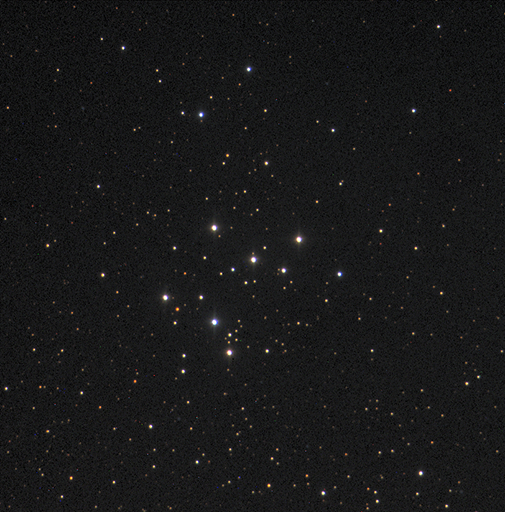2.2 Estimating magnitudes from an image
In the previous activity you estimated magnitudes visually by looking at stars in the real sky or using the image of Orion in Figure 1. This time the challenge is to match stars in an image against Stellarium and to estimate the magnitude of the faintest stars that you can identify. To do this, you will be taking our first look at an actual image from COAST.
Activity _unit4.3.1 Activity 4: Estimating magnitudes from a COAST image

- In this image you can see a group, or cluster, of stars referred to as Messier 29 or M29. This is an open star cluster so the stars are well separated, allowing you pick out individual stars.
- The aim of this activity is to identify a number of prominent stars in the image and to find their magnitudes using Stellarium and then to use these as a reference to estimate the magnitudes of other stars in the image.
- First, to find the cluster, start up Stellarium and set the date and time to 20:00 on the 21 December, making sure that you have the location set to the Teide observatory. Now use Stellarium’s search function to find M29, and zoom in until the field of view (FOV) displayed at the bottom of the screen indicates a field of view of about 0.4°
Adjust the zoom, keeping the cluster of stars in the centre of the screen, until the separation and distribution of the brightest stars approximately matches that in the image above. By clicking on stars in the Stellarium image you will find that detailed information is available for nine of the cluster’s stars. Check that you can identify each of the nine brightest stars in both the Stellarium display and the COAST image, in each case finding the corresponding star in both images.
[You may notice that the Stellarium display only shows a detailed image for the central part of the cluster. In the outer part of the cluster the COAST image is more detailed, showing more of the fainter stars than Stellarium. If you are using a tablet or mobile phone you may see fewer than nine stars.]
- Now look at the COAST image and try to decide which of your nine sample stars is the brightest and which is the faintest. Make a note of these. How hard is it to put them in order from brightest to faintest? What do you notice about the colour of these stars? If you have a good computer monitor, can you say which of the sample stars are bluer and which appear a little more red?
- Once you are comfortable with your own assessment of the sample stars in the COAST image, go back to the image in Stellarium and make a note of the magnitude values it gives for each star. What was the difference in magnitude between the brightest and faintest stars ? Is the star with the smallest magnitude the one which you identified as brightest in the COAST image? Don’t worry if your ordering of the sample stars using the naked eye does not exactly agree with the given values.
- Note that Stellarium only shows data for stars up to about magnitude 10. The COAST image contains many far fainter stars, indicating that COAST’s sensitivity goes well beyond magnitude 10. You may also have noticed that the colours of the stars are clearer in the COAST image.
You have now reached the limits of what can be done in Stellarium in terms of measuring fainter stars. In the second half of this course (Weeks 5 to 8) you will learn to use some additional tools in order to analyse COAST images in more detail as part of the variable star investigation, but for now you have seen how to match stars in an image from the telescope against those displayed in a reference image and carried out your first analysis of a real image from COAST.
